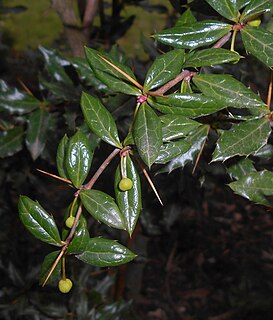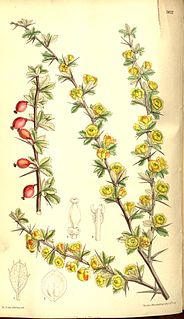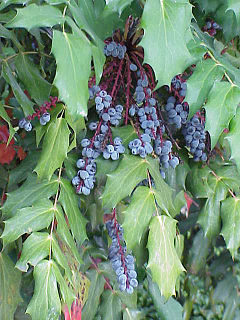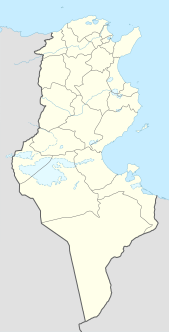
Mahonia is a genus of approximately 70 species of evergreen shrubs and, rarely, small trees in the family Berberidaceae, native to eastern Asia, the Himalaya, North and Central America. They are closely related to the genus Berberis and botanists disagree on whether to recognize a separate Mahonia. Many botanists prefer to classify Mahonia as a part of Berberis because several species in both genera are able to hybridize, and because there are no consistent morphological differences between the two groups other than the leaf pinnation. However, recent DNA-based phylogenetic studies retain the two separate genera, by clarifying that unifoliolate-leaved Berberis s.s. is derived from within a paraphyletic group of shrubs bearing imparipinnate evergreen leaves, which are then divided into three genera: Mahonia, Alloberberis, and Moranothamnus ; a broadly-circumscribed Berberis would also be monophyletic.

Berberis, commonly known as barberry, is a large genus of deciduous and evergreen shrubs from 1–5 m (3.3–16.4 ft) tall, found throughout temperate and subtropical regions of the world. Species diversity is greatest in South America and Asia; Europe, Africa and North America have native species as well. The best-known Berberis species is the European barberry, Berberis vulgaris, which is common in Europe, North Africa, the Middle East, and central Asia, and has been widely introduced in North America. Many of the species have spines on the shoots and all along the margins of the leaves.

The Berberidaceae are a family of 18 genera of flowering plants commonly called the barberry family. This family is in the order Ranunculales. The family contains about 700 known species, of which the majority are in Berberis. The species include trees, shrubs and perennial herbaceous plants.

Berberis microphylla, common name box-leaved barberry and Magellan barberry, in Spanish calafate and michay and other names, is an evergreen shrub, with simple, shiny box-like leaves. The calafate is native to southern Argentina and Chile and is a symbol of Patagonia.

Berberis vulgaris, also known as common barberry, European barberry or simply barberry, is a shrub in the genus Berberis. It produces edible but sharply acidic berries, which people in many countries eat as a tart and refreshing fruit.

Berberis thunbergii, the Japanese barberry, Thunberg's barberry, or red barberry, is a species of flowering plant in the barberry family Berberidaceae, native to Japan and eastern Asia, though widely naturalized in China and North America. Growing to 1 m (3.3 ft) tall by 2.5 m (8.2 ft) broad, it is a small deciduous shrub with green leaves turning red in the autumn, brilliant red fruits in autumn and pale yellow flowers in spring. Numerous cultivars are available as ornamental plants suitable for hedging.

Berberine is a quaternary ammonium salt from the protoberberine group of benzylisoquinoline alkaloids found in such plants as Berberis, such as Berberis vulgaris (barberry), Berberis aristata, Mahonia aquifolium, Hydrastis canadensis (goldenseal), Xanthorhiza simplicissima (yellowroot), Phellodendron amurense, Coptis chinensis, Tinospora cordifolia, Argemone mexicana, and Eschscholzia californica. Berberine is usually found in the roots, rhizomes, stems, and bark.
Camillo Karl Schneider was a German botanist and landscape architect. A farmer's son, he was born at Gröppendorf, in the Kingdom of Saxony, and worked as a gardener at Zeitz, Dresden, Berlin and Greifswald. Returning to Berlin to work in the City Parks Department, he assisted in editorial work for the periodical Gartenwelt, which led to his employ as a landscape assistant in Darmstadt and Berlin. In 1900, he moved to Vienna, where he practiced as a freelance architect and writer, travelling extensively through Europe. In 1904 he published his first books, including the beginning of his tome Illustrated Handbook of Broad-leaved Trees, which he completed in 1912. However, the manuscript of what should have been his magnum opus, a study of the genus Berberis, was destroyed in a bombing raid on Berlin in 1943.
Berberis bicolor is a shrub in the Berberidaceae described as a species in 1911. It is endemic to Guizhou Province in China. Its local common name is 二色小檗.

Berberis candidula is a species of plant in the family Berberidaceae. It is endemic to China, native to the provinces of Hubei and Sichuan.
Berberis silvicola is a species of plant in the family Berberidaceae. It is endemic to China.
Berberis taronensis is a shrub in the Berberidaceae described as a species in 1941. It is native to Tibet and Yunnan in China.

Berberis dictyophylla, the netleaf barberry, is a deciduous shrub in the genus Berberis which is native to Western China.

Berberis julianae, the wintergreen barberry or Chinese barberry, is a flowering evergreen shrub native to Central China. It is widely grown as an ornamental in other temperate regions. It is reportedly naturalized in scattered parts of the United States.
Berberis amoena is a shrub native to the Sichuan and Yunnan provinces of China. It is found at elevations of 1600–3100 m.

Berberis bealei, also known as leatherleaf mahonia, Beale's barberry, or Oregon grape, is a species of evergreen shrub native to mainland China. The species has been regarded as the same species as Berberis japonica, native to Taiwan, but the two differ consistently in certain floral and leaf characters. Both species are widely cultivated in many countries as ornamentals. Berberis bealei has reportedly escaped cultivation and become established in the wild in scattered places in the south-eastern United States from Arkansas to Florida to Delaware.
Berberis sikkimensis is a plant species native to the high Himalayas at elevations of 2000–3000 m. It is known from Sikkim, Nepal, Bhutan, Tibet and Yunnan.

Berberis gagnepainii, or Gagnepain's barberry, is a species of flowering plant in the family Berberidaceae, first described in 1908. It is endemic to China, known from Guizhou, Hubei, Sichuan, and Yunnan Provinces.

Thenae or Thenai, also written Thaena and Thaenae, was a Carthaginian and Roman town located in or near Thyna, now a suburb of Sfax on the Mediterranean coast of southeastern Tunisia.











